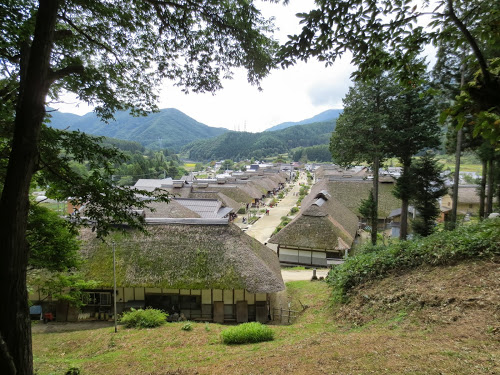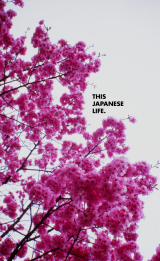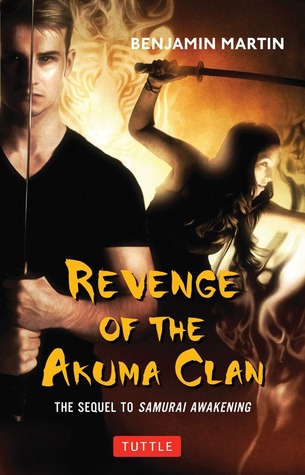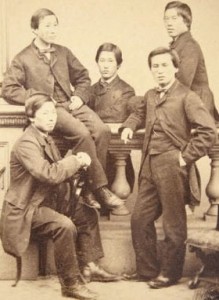I’ll Make It Myself!: Japan-Friendly Thanksgiving Recipe Ideas
Leah Zoller (CIR Ishikawa-ken, Anamizu, 2009-11) is the editor of The Ishikawa JET Kitchen: Cooking in Japan Without a Fight. She works in international student exchange; writes I’ll Make It Myself!, a blog about food culture in Japan and the US; curates The Rice Cooker Chronicles, a series of essays by JETs and JET alumni on the theme of cooking/eating and being alone in Japan; and admins The JET Alumni Culinary Group on LinkedIn.
Hosting two Thanksgivings in Japan taught me to love the holiday and its food again. My friends are amazing cooks, and the sheer sense of community, of getting together to remake a tradition in our own way really made the holiday feel special.
Last year, I did a recipe-roundup of our meal. This year, I’d like to offer more recipes and suggestions for making Thanksgiving special in Japan or wherever you are.
I’ll Make It Myself!: Millet Muffins
L.M. Zoller (CIR Ishikawa-ken, Anamizu, 2009-11) is the editor of The Ishikawa JET Kitchen: Cooking in Japan Without a Fight. Ze works in international student exchange; writes I’ll Make It Myself!, a blog about food culture in Japan and the US; curates The Rice Cooker Chronicles, a series of essays by JETs and JET alumni on the theme of cooking/eating and being alone in Japan; and admins The JET Alumni Culinary Group on LinkedIn.
Check out the rice section in your local supermarket in Japan for other grains, and you’re often find zakkoku (雑穀) / kokumotsu (穀物), mixed grains and beans, which often includes millet. Millet is called awa (粟) or kibi (キビ) and is often sold by itself as uruchikibi (うるちキビ ) or mochi kibi (モチキビ).
I’ll Make It Myself!: Mister Donut Halloween Donuts 2013
L.M. Zoller (CIR Ishikawa-ken, Anamizu, 2009-11) is the editor of The Ishikawa JET Kitchen: Cooking in Japan Without a Fight. Ze works in international student exchange; writes I’ll Make It Myself!, a blog about food culture in Japan and the US; curates The Rice Cooker Chronicles, a series of essays by JETs and JET alumni on the theme of cooking/eating and being alone in Japan; and admins The JET Alumni Culinary Group on LinkedIn.
Last year’s Halloween-themed pumpkin-flavored Mister Donuts doughnuts were delicious. This year, they’ve added a ghost and Hello Kitty shapes, and it appears that the batter is normal but the icing is kabocha-chocolate flavored.
Omiyage and Gift Giving in Japan
Posted by Benjamin Martin, a JET from 2008-2013 in Okinawa, publisher of the blog MoreThingsJapanese.com and author of the award-winning YA fantasy series Samurai Awakening (Tuttle).
Do you like souvenirs? Do you collect trinkets? Maybe you love trying various foods that are unique to a town or area. If you do, Japan might be the place for you.
Gifts are (arguably) one of the central aspects of Japanese culture. For those of you that point to Christmas in western cultures, Hanukkah, or other massive gift exchanges as an argument against gifts being such a big deal, it comes down to perspective. For single-day gift giving Japan does not stand toe to toe with a pile of presents around a Christmas tree or a mass onslaught of birthday gifts. Yet, when I was a teacher on Kitadaito I got presents nearly every week. Once I received seven (yes 7) strawberry plants, for no reason at all. But then there are two major aspects to gift giving in Japan.
Omiyage
 Omiyage roughly means souvenir. Whenever a person goes anywhere in Japan, they generally buy a load of omiyage for their co-workers and family. For big trips this can sometimes be toys, figures, pictures, or anything that you might normally associate with souvenirs. More often its food. Japan has a massive industry around tourism. Almost anywhere you go in Japan has its own snack food that it’s ‘known for.’ There are almost always shops, small to large, that will sell the treats conveniently and individually wrapped and ready for you in a bag. In Okinawa, benimo (purple sweet potato tarts) are the most well known omiyage. In Kyoto there are various kinds of mochi, and on Kumejima we’re known for our Miso Cookies. Nagasaki is famous for Kastella Cakes, and most local places have unique omiyage for each location.
Omiyage roughly means souvenir. Whenever a person goes anywhere in Japan, they generally buy a load of omiyage for their co-workers and family. For big trips this can sometimes be toys, figures, pictures, or anything that you might normally associate with souvenirs. More often its food. Japan has a massive industry around tourism. Almost anywhere you go in Japan has its own snack food that it’s ‘known for.’ There are almost always shops, small to large, that will sell the treats conveniently and individually wrapped and ready for you in a bag. In Okinawa, benimo (purple sweet potato tarts) are the most well known omiyage. In Kyoto there are various kinds of mochi, and on Kumejima we’re known for our Miso Cookies. Nagasaki is famous for Kastella Cakes, and most local places have unique omiyage for each location.
Often, when teachers go on trips, they bring back a packet of cookies, tea, or other snacks for the break room. Sometimes teachers will bring back more personal gifts for people depending on where they went and why.
Other Gifts
Aside from omiyage gifts are given for weddings (cash), birthdays, funerals (cash), and other special events. Gifts are even given by new tenants to their neighbors (usually something useful, like a small towel, or food). These other gifts have their own customs for every situation. Cash for weddings should be new and in the proper envelope, while cash for funerals the money should be used, and in a different envelope. Aside from omiyage most presents are wrapped as well (even souvenirs are sometimes wrapped).
Reciprocal Gifts
In Japan it is usually appropriate to give a return gift of roughly half what you received for most occasions. The exceptions are omiyage and birthday presents, though usually you would return in kind if you go on a trip, etc. Even mourners will return small gifts of towels or rice coupons. This tradition is what makes gift-giving a cornerstone of Japanese Culutre. It is one of the foundations of polite Japanese society, and the reason for my new strawberry plants.
Reciprocal gift giving forms a kind of endless circle of ‘obligations’ that help to create relationships in a society where it is difficult to break down social barriers. When a new neighbor arrives and gives a small present, there is a unique opportunity for conversation. A return gift (though in this instance you are not required to give a return gift, it,s they way of saying ‘regard me kindly while I am living next to you’) is another opportunity. It goes deeper.
When you do someone a favor, they feel an obligation towards you, and want to return the favor. It creates a cycle that goes far beyond what most westerners are used to, usually in a good way. Sometimes when I make too much food, I’ll take some over to a friend’s or neighbor’s. Almost without fail I get something interesting in return. One might be tempted to take the cynical view: you are bribing someone for their friendship. But in Japan, it’s so ingrained that many people don’t even think about it, if they get something, be it a favor, food, or gift, they will return it.
I’m not sure what I did to deserve my new plants, but I made some banana bread as a thank you.
Originally published on MoreThignsJapanese.com
Goodreads Book Giveaway
Revenge of the Akuma Clan
by Benjamin Martin
Giveaway ends October 31, 2013.
See the giveaway details
at Goodreads.
I’ll Make It Myself!: Halloween Kit Kats 2013: Where’s the Pumpkin?
L.M. Zoller (CIR Ishikawa-ken, Anamizu, 2009-11) is the editor of The Ishikawa JET Kitchen: Cooking in Japan Without a Fight. Ze works in student exchange; writes I’ll Make It Myself!, a blog about food culture in Japan and the US; curates The Rice Cooker Chronicles, a series of essays by JETs and JET alumni on the theme of cooking/eating and being alone in Japan; and admins The JET Alumni Culinary Group on LinkedIn.
Halloween Kit Kats in Japan and US.
Let’s enjoy Halloween!
A standard Halloween dessert, pumpkin pudding has a sweet and gentle flavor that fills the mouth. Enjoy Halloween even more with pumpkin-pudding flavor Kit Kats. (Nestle Kit Kats Mini Pumpkin Pudding Flavorネスレ キットカット ミニ パンプキンプリン味)
CIR continues Fukushima Live blog: Stories from people living in Fukushima prefecture
 Saw the link for this posted by Eden Law to the JETAA Oceania Facebook group. Here’s a sample post:
Saw the link for this posted by Eden Law to the JETAA Oceania Facebook group. Here’s a sample post:
http://fukushimalive.blogspot.jp
“This blog Fukushima Live collects stories from people living in Fukushima Prefecture”
Hi everyone, my name is William. I’m one of the new CIRs here in Fukushima Prefecture, and am taking over for Lachie Tranter in the International Affairs Division. Lachie has kindly allowed me to continue his Fukushima Live blog. I hope to be able to continue to share with you all life in Fukushima, the challenges people here are facing, and many of the wonderful attractions the prefecture has to offer.
Recently I had the opportunity to travel around the Aizu Region here in Fukushima Prefecture. Aizu, the westernmost region of the three regions in Fukushima, is known for its rich history and sake-brewing industry.
The highlight of the trip was visting Ōuchi-juku. Located in the mountains of Minami-Aizu, Ōuchi-juku was a post town during Japan’s Edo period (1603 – 1868). It is famous for the traditional thatched buildings that line its main street, allowing visitors to experience the atmosphere of the Edo period here in modern day Japan.
Book: “This Japanese Life” published by JET alum blogger Eryk Salvaggio
 Thanks to AJET Chair Kay Makishi for the heads up on Fukuoka JET alum Eryk Salvaggio who writes the blog “This Japanese Life” and recently published a book by the same name. You can read more about Eryk in this Japan Times interview with him from 2012.
Thanks to AJET Chair Kay Makishi for the heads up on Fukuoka JET alum Eryk Salvaggio who writes the blog “This Japanese Life” and recently published a book by the same name. You can read more about Eryk in this Japan Times interview with him from 2012.
About the book: http://thisjapaneselife.org/this-japanese-life-the-book/
Most books about Japan can tell you how to use chopsticks or say “konnichiwa.” Few tackle the real stress of life in a radically different culture.
The author, a three-year resident and the writer and researcher behind one of the best Japan blogs, tackles the thousand tiny uncertainties of life abroad with honesty and wit.
Perfect for anyone about to leave home for Japan or elsewhere, This Japanese Life will deepen any reader’s understanding of Japanese culture as it’s fused into a method of dealing with the hardships of working and living there.
About Eryk:
Eryk Salvaggio was an American newspaper editor in Bangor, Maine before teaching English in Japan with the JET Program. He lived in Fukuoka City from 2010-2013, writing a blog, This Japanese Life, about Japanese culture and the tiny anxieties of being an expatriate.
The site was named one of the best Japan Blogs by Tofugu and was spotlighted by The Japan Times. Salvaggio has written for McSweeney’s, The Japan Times, Tofugu and Kulturaustausch.
His work as a visual artist has been covered in The New York Times and elsewhere.
He currently lives in London.
I’ll Make It Myself: New Resource: Food Substitutions for Cooking and Baking in Japan
L.M. Zoller (CIR Ishikawa-ken, Anamizu, 2009-11) is the editor of The Ishikawa JET Kitchen: Cooking in Japan Without a Fight. Ze also writes I’ll Make It Myself!, a blog about food culture in Japan and the US; curates The Rice Cooker Chronicles, a series of essays by JETs and JET alumni on the theme of cooking/eating and being alone in Japan; and admins The JET Alumni Culinary Group on LinkedIn.
Throughout my four years in Japan, I had to figure out solutions to issues with ingredient availability and cooking equipment to be able to eat the food I wanted. I’ve just started a new resource with some of my tips for what to substitute and what to make at home. Some of them seem really obvious, but they weren’t to me at the time.
I’ll Make It Myself!: Kitchen Library, 2013.8.29: Japanese Food
L.M. Zoller (CIR Ishikawa-ken, Anamizu, 2009-11) is the editor of The Ishikawa JET Kitchen: Cooking in Japan Without a Fight. The Japan and International Programs Coordinator for NorthWest Student Exchange, ze also writes I’ll Make It Myself!, a blog about food culture in Japan and the US; curates The Rice Cooker Chronicles, a series of essays by JETs and JET alumni on the theme of cooking/eating and being alone in Japan; and admins The JET Alumni Culinary Group on LinkedIn.
Putting the focus on links about Japanese food, I submit for your approval adorable animal doughnuts, what is and isn’t healthy about “the Japanese diet,” wagashi, and more!
I’ll Make It Myself!: The Best Sakura Soft Cream in Town: Kyokusuien
L.M. Zoller (CIR Ishikawa-ken, Anamizu, 2009-11) is the editor of The Ishikawa JET Kitchen: Cooking in Japan Without a Fight. Ze also writes I’ll Make It Myself!, a blog about food culture in Japan and the US; curates The Rice Cooker Chronicles, a series of essays by JETs and JET alumni on the theme of cooking/eating and being alone in Japan; and admins The JET Alumni Culinary Group on LinkedIn.
New Rice Cooker Chronicles submissions always welcome. Just e-mail it to jetwit [at] jetwit.com.
I’ll Make It Myself!: Baudrillard and the Food Truck: Dragon Fest 2013
L.M. Zoller (CIR Ishikawa-ken, Anamizu, 2009-11) is the editor of The Ishikawa JET Kitchen: Cooking in Japan Without a Fight. Ze also writes I’ll Make It Myself!, a blog about food culture in Japan and the US; curates The Rice Cooker Chronicles, a series of essays by JETs and JET alumni on the theme of cooking/eating and being alone in Japan; and admins The JET Alumni Culinary Group on LinkedIn.
New Rice Cooker Chronicles submissions always welcome. Just e-mail it to jetwit [at] jetwit.com.
One of the aspects I hadn’t anticipated as much regarding my culture shock expectations was adjusting to Americanized- and fusion Japanese food, especially for foods that I encountered for the first time in Japan. This isn’t to say that American-Japanese food isn’t delicious–quite the contrary–but it can be a bit alarming at times to see sushi rolls cooked tempura-style (why?) or cilantro in your temaki (YES). If nothing else, it serves as a reminder of my relative inexperience with the Japanese home cooking when I left to study abroad in university and the problematic nature of the idea of a food’s authenticity.
Dragon Fest is an annual celebration of pan-Asian cultures held in Seattle’s International District.
I’ll Make It Myself!: Raspberry-Almond Mini Baked Oatmeals
L.M. Zoller (CIR Ishikawa-ken, Anamizu, 2009-11) is the editor of The Ishikawa JET Kitchen: Cooking in Japan Without a Fight. Ze also writes I’ll Make It Myself!, a blog about food culture in Japan and the US; curates The Rice Cooker Chronicles, a series of essays by JETs and JET alumni on the theme of cooking/eating and being alone in Japan; and admins The JET Alumni Culinary Group on LinkedIn.
New Rice Cooker Chronicles submissions always welcome. Just e-mail it to jetwit [at] jetwit.com.
Note: if you’re in Japan and sans raspberries, never fear! There are plenty of seasonal and local adaptations.
One of my go-to breakfast recipes is Heidi Swanson’s baked oatmeal (via Lottie & Doof). Extremely versatile, you can swap in any seasonal local fruit you like–in Japan, I often used persimmons, apples, or figs instead of bananas on the bottom; diced apples, raisins, or mikan mixed in when blueberries were out of season; and, best of all, it fit in a moven in a 20×20 cm (8×8 in) pan. The recipe will always remind me of my Kanazawa kitchen.
Around Japan in 47 curries: Iwate cheese
Tom Baker (Chiba, 1989-91) is writing a 47-part weekly series of posts on his Tokyo Tom Baker blog, in which he samples and comments on a curry from a different prefecture each week. Here’s an excerpt from his ninth installment, about Iwate Prefecture.
When I first came to Japan, I found some Koiwai cheese in a supermarket and mistook it for an American product. After all, Kiowa – as I initially misread the name – has an American ring. (The Kiowa are a Native American tribe.)
However, I now know the history of Koiwai cheese – and its unusual name – goes all the way back to the adventures of the Choshu Five, a group of young men who secretly left Japan in 1863 to study in Britain. After their return, they became leading figures in the country’s rapid modernization. One of them, Masaru Inoue, is remembered as “the father of the Japanese railways.”
In 1888, Inoue visited Iwate to inspect the progress of railway construction there. According to the Koiwai website, the volcanic soil and barren-looking windswept terrain struck him as a promising area for ranching…
I’ll Make It Myself!: Localizing Big Boy
L.M. Zoller (CIR Ishikawa-ken, Anamizu, 2009-11) is the editor of The Ishikawa JET Kitchen: Cooking in Japan Without a Fight. A recent returnee, ze also writes I’ll Make It Myself!, a blog about food culture in Japan and the US; curates The Rice Cooker Chronicles, a series of essays by JETs and JET alumni on the theme of cooking/eating and being alone in Japan; and admins The JET Alumni Culinary Group on LinkedIn.
New Rice Cooker Chronicles submissions always welcome. Just e-mail it to jetwit [at] jetwit.com.
…During a work conference in Chiba that first fall, I ended up out for a quick lunch at Big Boy, which is essentially a hamburger-and-standard-”American”-fare family restaurant in the US. In Japan, as with most “Western food” family restaurants, Big Boy has been cleverly localized. There are no hamburgers, only hamburg plates.
 Heather Wilson Tomoyasu (ALT Ibaraki-ken, 2004-06), previously Manager of Public Relations at the Japanese Chamber of Commerce, is now a newly established work-at-home mom – owner of Miny Moe (selling diaper & nursing pad samplers), “Expert Mom” for the app Mommy Nearest, and blogging in Brooklyn on her site US-Japan Fam.
Heather Wilson Tomoyasu (ALT Ibaraki-ken, 2004-06), previously Manager of Public Relations at the Japanese Chamber of Commerce, is now a newly established work-at-home mom – owner of Miny Moe (selling diaper & nursing pad samplers), “Expert Mom” for the app Mommy Nearest, and blogging in Brooklyn on her site US-Japan Fam.
No, He’s Not Adopted!: My husband is Japanese and I’m your standard run of the mill white American. As soon as we got pregnant, everyone was all “You are gonna have the cutest baby EVER!!!” which was fun to hear (a million times!) but how do you respond to that? “Thanks”? “I hope so”? We were riddled with a mixture of curiosity and anxiety over what our lil’ munchkin would look like… <CONTINUE>
 Giveaway: Diapers, Nursing Pads, & Wipes!!: If you are expecting, have a little one at home, or have a friend’s baby shower coming up, I hope you’ll enter my giveaway this week! We’re offering 1 Miny Moe Newborn Diaper Sampler (5 diapers from each of 6 brands), 1 Miny Moe Disposable Nursing Pad Sampler (1 pair from each of 3 brands), and 1 Diono Travel Wipes.
Giveaway: Diapers, Nursing Pads, & Wipes!!: If you are expecting, have a little one at home, or have a friend’s baby shower coming up, I hope you’ll enter my giveaway this week! We’re offering 1 Miny Moe Newborn Diaper Sampler (5 diapers from each of 6 brands), 1 Miny Moe Disposable Nursing Pad Sampler (1 pair from each of 3 brands), and 1 Diono Travel Wipes.
Go to the blog to see more posts!!
Comments on entries are always appreciated, and guest bloggers are welcome to use the contact form on the blog site to submit ideas!
JETwit note: CLICK HERE to join the JET Alumni Parents group on Facebook.














